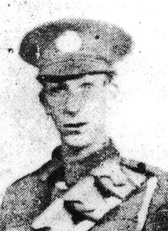 Captain David Salomons
Captain David Salomons Southborough and Tunbridge Wells when a large number of men died in an accidental collision with another British troopship, only seventeen days after
they had left from home to join the conflict in Turkey.
Ninety-seven years ago, on 28 October 1915, the troopship HMS Hythe was sunk approaching the Dardanelles. HMS Sarnia, another troopship steaming away from shore after disembarking her troops, collided with the Hythe, which went down in ten minutes. The Hythe was sailing without lights in order to avoid detection by Turkish batteries on the shore. There were 275 men on board including crew, and 154 of them drowned. 129 of these were men of the 1st/3rd Kent Field Company, Royal Engineers, from Tunbridge Wells, Southborough, and the surrounding region. Twenty-four of them are named on Southborough War Memorial.
The Company's initial training took place in Sheffield Hall, Draper Street, Southborough, then in the former gasworks in Speldhurst Road, later converted by Sir David Salomons at his personal expense into a well-equipped drill hall. Sir David was Honorary Colonel of the Kent (Fortress) Royal Engineers. The Company left their depot at Gillingham on 11 October 1915, and sailed from Devonport the following day in the converted liner Scotian, not
knowing that the government was already preparing to abandon the Gallipoli operation as a lost cause. During the voyage, Captain David Salomons, the only son of Sir David, wrote of his pride in the men, though fearing few appreciated the dangers into which they were sailing. The men were transferred to HMS Hythe, a converted cross-Channel ferry, on the morning of 28 October.
 Frederick Somers
Frederick Somers The Army officers were allowed to enter the engine room for warmth for most of the journey, and the men crowded the decks, the drivers to the fore well deck and the sappers to aft during the passage. Accounts speak of being very crowded, almost shoulder to shoulder. Because of the weather and the choppy seas, an awning was erected from side to side of the
Hythe to provide some overhead cover against rain and spray, and many of the soldiers huddled underneath. The men did as many other soldiers have done when together and nowhere to go; they talked, sang popular songs, slept if they could or sat with private thoughts and wishes for the future. This was very much a family unit, with many knowing each other through school, cricket team, football team, living in the same road etc.
Driver Fred Mills, from Speldhurst, was one of those who watched the disaster unfold and
survived. He saw the Sarnia bearing down on the Hythe just seconds before the collision. The Hythe’s crew had just time to give a warning blast on the siren before the heavier ship hit them forward of the bridge, ploughing into the little vessel’s side, almost cutting her in two. The Hythe’s commander, sensing that the ship was about to go down, called to
Captain Salomons, “Come on, jump. This is your last chance. I am going now." But Salomons stood firm, saying, “No, I will see my men safe first”. He was seen with Company Sergeant Major John Carter, trying to launch a lifeboat. They stood on the bridge, Salomons exhorting his men to keep cool and try to save themselves. They went down with the ship as it slid under the waves.
Fred Mills recalled:"I think I can sacredly say that he died trying for others as he was with the other officers who were saved. Our Major had to take to the water only but for remaining almost to the last, and I am told he wanted the Captain to follow. One of the Sappers who was late himself in leaving the ship as she was sinking said the last he saw of him was trying to lower a boat. If he was not thinking of others one would imagine he would have gone straight for his own Life Belt of which he had a beauty and would be impossible for him to sink in that time. It is my own opinion if he had of thought of himself first he would have been saved, and if I am right he died a hero’s death and we honour him.”
A large number of men who lived along Silverdale Road in High Brooms died in the Hythe disaster. It is recalled anecdotally that the postman delivering news of their death along this road became so overwhelmed by the distress his delivery was causing that he turned back to his depot before he had completed his round.
 Harry Goldbaum
Harry Goldbaum  Thomas Godsmark
Thomas Godsmark  Thomas Handley, seated, at family wedding
Thomas Handley, seated, at family wedding attended by five survivors of the Hythe, as a result of the naming of Hythe Close in London Road, Southborough.
The men are also commemorated on the Helles Memorial, on the Gallipoli Peninsula in Turkey as well as their home war memorials in Kent. Two houses, Hythe (No 8) and Sarnia (No 6), in Gordon Road, High Brooms were built in the 1930s for a survivor of the Hythe disaster, Edmund Cavie.
For many years, on 28th October, the survivors of the Hythe disaster, and the families of those lost, paraded from the Drill Hall in Speldhurst Road (now
the site of the New Life Church) to Southborough War Memorial, to honour the dead, but this practice was discontinued in the 1960s, no doubt due to old age and a lack of public participation.
Frank Stevens of Tonbridge has worked very hard to record the story of the Hythe disaster. His excellent book Southborough Sappers of the Kent (Fortress) Royal Engineers includes a great deal of carefully-researched detail for anyone interested in reading further on the subject. Frank will be speaking about the Hythe disaster at a meeting of the Southborough Society on 15 January 2013.

 RSS Feed
RSS Feed
